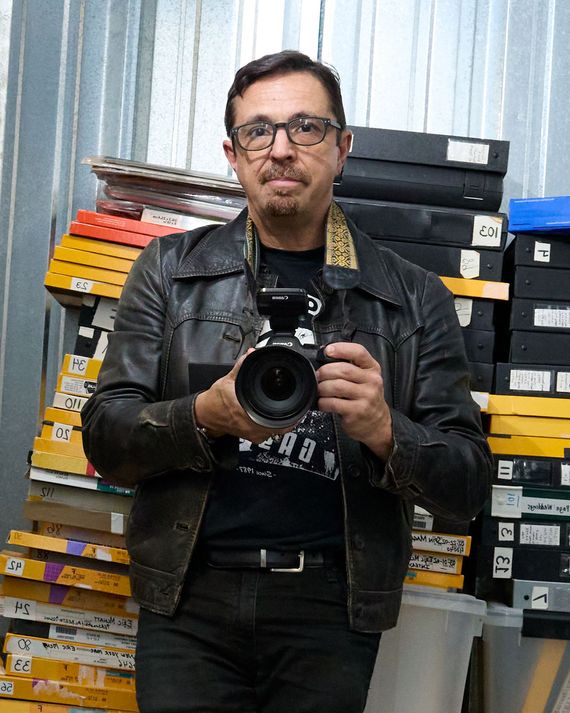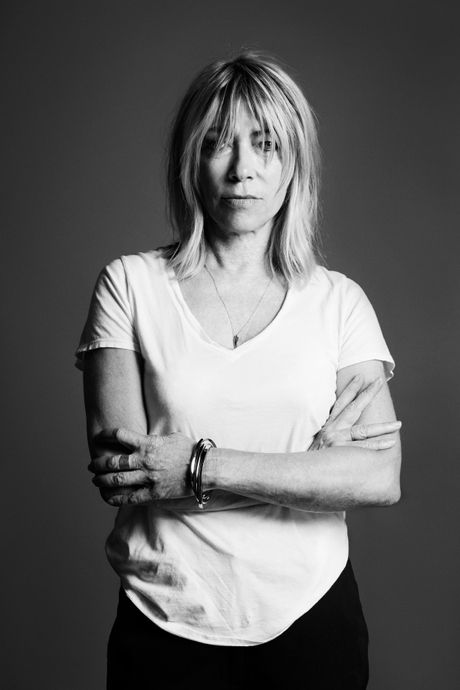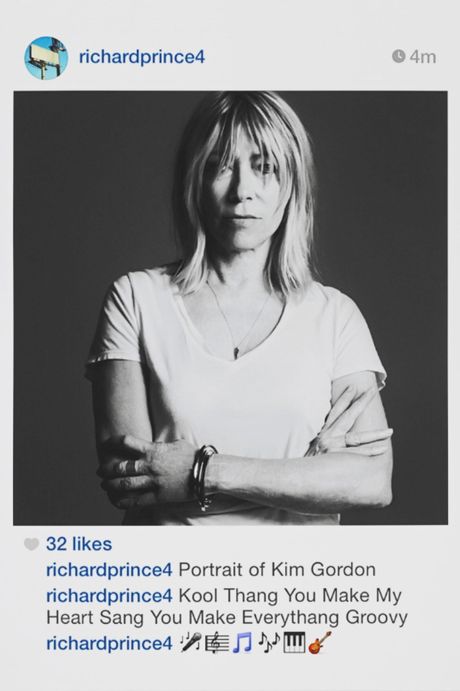
A decade ago, Eric McNatt made a portrait of Kim Gordon for Paper magazine. He was paid $100. Working for Paper has never really been about the money; you get to do something cool with someone interesting, and it often pays off in other ways. This portrait — black and white, austere but playful, with the rock star’s arms folded — instead led to him feeling like he was ripped off by a famous artist, Richard Prince, and betrayed by Gordon herself. What resulted was eight arduous, intrusive years of litigation ending in a judgment with a $450,000 payment from Prince to McNatt.
I knew McNatt when we were much younger, but I hadn’t seen him in decades. Over those years, a career as a writer or photographer in what’s left of the magazine business had become a more or less volunteer activity for many. “I came in at the tail end of an industry where I got paid well for the work,” McNatt said. “I did for almost 15 years make a living as an editorial photographer. But those days don’t exist anymore.”
Around the time of the Paper shoot, Prince, who became rich and famous appropriating other people’s images (Marlboro ads, pulp-novel covers, a skeevy nude portrait of an underage Brooke Shields), had been introduced to Instagram by one of his school-age children. Prince had the idea that, to show how stupid we all are for being glued to our phones and showing off for each other, he would screengrab other people’s Instagram posts (most often, they were of fetching young women), add his own nonsense commentary as a literal commenter on the post, then produce poster-size inkjet prints of them. That is just what he did with the portrait of Gordon after McNatt posted it on Instagram.


Prince’s exhibitions of these metaworks at Gagosian in 2014 and Blum & Poe in 2015 were called “New Portraits.” The Gordon piece sold for $90,000.
“I was like, What the fuck am I going to do with this? I was having my own personal health issues and my mom was going through a lot and it was just too much, so I let it go,” McNatt said.
Then Gordon posted a picture of herself holding the McNatt-derived Prince piece on her own Instagram in 2016 with the caption “So thrilled thank you @richardprince4.” “I lost my shit,” McNatt said.
“Kim Gordon was basically stabbing me in the heart with that post,” he said. “It was hard to see someone that I know recognizes art and champions artists, someone I idolized and looked up to my entire childhood and teenage years, then acting like you don’t exist? That hurt a lot.”
McNatt decided to sue.
Everyone involved here is still an outsider punk kid in their own mind. Gordon, once an artist and gallery employee living on Eldridge Street, went to hide from art in the music world and ended up a counterculture star. Prince, now described by his lawyers in court as “one of the most important, internationally recognized contemporary artists,” is still the guy who watched his art-world friends all get famous in the ’80s while his work lingered in Barbara Gladstone’s basement — not rich and famous until well into his 40s, he still carries that chip on his shoulder. Gordon and Prince were friends; he made the cover of the Sonic Youth album Nurse.
McNatt is from Austin and moved to New York via San Francisco in the ’90s, shooting for mainstream mags and music labels, a part of a queer bohemian cohort that, loosely, included the novelist Alexander Chee, the playwright Jorge Ignacio Cortiñas, the choreographer Miguel Gutierrez, and the performer Justin Vivian Bond. This is partly why he shot for places like Paper: There was a continuity between his world and that of the previous generation of artists like Gordon. Downtown people see themselves that way forever, somehow in it together as outsiders, whatever their personal fortunes. Maybe that’s why it felt so bad.
Prince is doing his small part to leave a legacy of litigation around American copyright. At the same time, a steady tide of other cases around art, copyright, and fair use have recently come to various but not particularly clarifying ends.
Prince’s best work can be childish and hilarious and also austere and wistful. A series of paintings secretly done in disappearing ink hit right at the heart of the power of collectors and dealers by evaporating off their walls. His games feel less successful in work like the Instagram series: Intended to criticize social-media titans and our own behavior on their platforms, it can feel like he is punching down instead.
It certainly felt that way to McNatt. He found a photographer named Donald Graham, who was suing Prince over another work in the same series, and reached out to that artist’s lawyer, Christopher Davis at Cravath. Cravath took on McNatt’s litigation pro bono in part to help clarify certain issues in copyright law, using students at Columbia Law School to kick around early ideas.
“I was really interested in what the public perception of the litigation would be,” Davis said. “When Napster hit, the idea at that time, for younger people in particular, seemed to be that everything is free. So I suspected so-called digital natives might rally behind Prince, behind the idea that copyright is an outdated thing. I was pleasantly surprised when that did not seem to be the reaction.”
Reading the case over now, years pass in a blink. At one point, a lawyer leaves for a new job and then returns to his original firm, rejoining the case. “Too many people are spending too much time on this,” the judge said at one point. Arguments of all kinds are made: Lawyers for Prince assert that Instagram’s terms of service grant a “non-exclusive implied license,” supposedly allowing anyone to make use of any photo posted on Instagram, an innovative interpretation of which entity those terms are intended to benefit (actually Instagram itself, of course). By 2018, the parties had already discussed settlement. McNatt was deposed; the lawyers tore through McNatt’s own Instagram history to dredge up every time he’d posted an image by another photographer.
Gordon, for her part, let it be known that she believed McNatt had no rights to her image and was unhappy when he licensed the photo for another $100 to Vogue: “Ms. Gordon has unequivocally stated that she did not and will not provide McNatt permission to further exploit her image,” Prince’s lawyers wrote; the copyright, of course, is McNatt’s.
Apart from that, much of their narrative was persuasive, though little of it felt good. Prince’s lawyers said the works were natively different categories of things, because “the market consumed the Prince work at nearly 1000 times more than the amount of the McNatt work.”
“When that stuff started rolling in, it hurt, but there’s a part of me that had to say it’s true,” McNatt said. He also felt the stakes grow as the years went on. He turned 50; the pandemic came; his computer had to be forensically examined. “I knew that if I lost my shirt” — if, for instance, he had to pay years of lawyer’s fees for Prince — “I would have to declare bankruptcy,” he said. “I’ve been poor my whole life. What am I going to lose?”
He had to look at every job he’d ever done over decades. He was able to track the decline of his fortunes, his art career held together by a rent-controlled East Village apartment. “Even though it was difficult, I could really see how my life shaped itself,” he said. Who would he be now? As the case ground on, he began photographing for nonprofits, and he took on teaching at FIT. This work made him feel happy and creative again.
In late 2022, the judge wrote an extensive analysis of the case. “The only real input by Prince was he said that he wanted to make them more ‘fun.’ The judge looked at the actual pieces and said it isn’t evident there’s much commentary here, based on a few pithy captions,” said Scott Burroughs of Doniger Burroughs, an IP firm in Venice and New York that often represents photographers as copyright plaintiffs and wasn’t involved in this case.
“I did not decide as a matter of law that Prince’s use was not fair. I simply decided that I could not, as a matter of law, decide that it was fair,” the judge explained in mid-January as they prepared for a trial date, at last, this March. That would be a jury’s job.
Gordon was on the witness list. Wealthy art collectors and dealers would parade in. Prince would likely not testify, which was, for him, for the best: When he speaks, he sounds like the very stereotype of the careless, elitist, marauding artist.
And then, on the eve of trial, it all went away; Prince and McNatt agreed on payment terms and language and everyone abruptly went home.
Prince’s Kim Gordon piece had been purchased by a collector and sometime actor named Alexander DiPersia and/or his mother. When news of the abrupt end of the case came in, DiPersia posted just a corner of the piece, with what looked like caution, on his own Instagram. The caption wished Prince “congrats.”
The lack of a trial created a sudden vacuum in the relationship between the parties. With no further forum for their passions, and a lifetime’s worth of otherwise billable hours expended, the conflict continued in the press, something we tend to encourage.
“In my mind, this icon of appropriation art has finally been held responsible. All the things, except the jury checking the box, we got in the judgment,” said David Marriott, the Cravath litigation partner on McNatt’s case. “Would a trial have splashed more publicly? Yeah, sure. Defendants would have had an even harder time trying to spin the outcome as just another favorable settlement.”
“It is completely understandable that plaintiff’s counsel would be disappointed in the judge’s legal rulings before trial and attempt to spin the result,” said Brian Sexton, who represents Prince. “Sadly, this is the world we live in now. No one ever admits defeat in sports, politics, or the law anymore, despite what the scoreboard says.”
“This is a very pro-art victory, I believe,” Cravath’s Davis said. “You will be rewarded for your original creations. There is a line there. Fair use is an exception to copyright — not the other way around.”
“We are extremely pleased with the ultimate outcome of this case and that there was no negative or regressive ruling on the fair use doctrine that could be used to chill free speech and dissuade artists, especially young and emerging artists, from making new art,” said Sexton.
Of course, none of this had to happen. “There’s a system in place to address that type of work, which is the licensure system,” said Burroughs. “All you have to do under that system is contact the originator of this work. And I’m sure everyone would have been happy.” But that’s boring, and Richard Prince would never. Artists and lawyers alike love mess.
“Cases exist because of people,” said Claudia Ray, a partner at Kirkland & Ellis in the firm’s IP department. “And people will always think of new things. That’s what copyright is designed to protect. It’s not a field that’s ever going to be boring.”
But did this case matter? “I’m sure it’s a case that’s going to be cited,” Ray said. “You can look at it and say, ‘This looks like our case or doesn’t look at our case.’ But does it answer any questions we have about fair use? None of them do. That’s the nature of the beast.”
McNatt had to hire a financial adviser for the first time in his life. $450,000 — even less all the fees, of course — was a lot of money for him, if maybe not so much for Prince.
Journalists like to say that people should never seek emotional satisfaction from the courts. What if we’re wrong? “I know that I moved the dial on this,” McNatt said. “It might have been an inch. It might have been two inches. It was important for me for there to be something to build on for the next person.”





